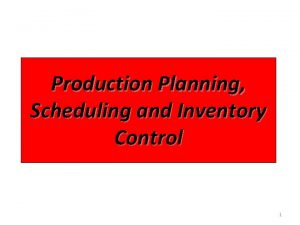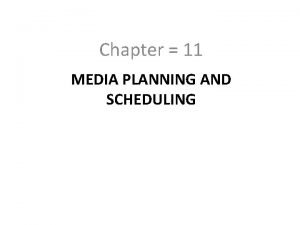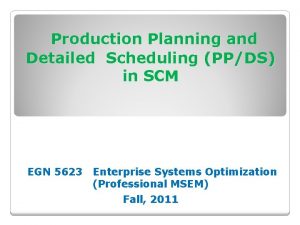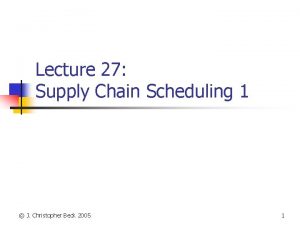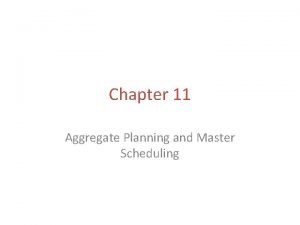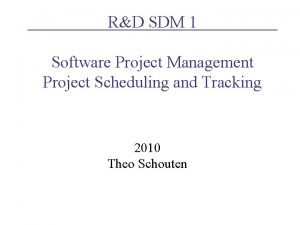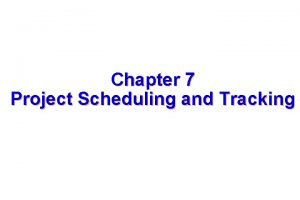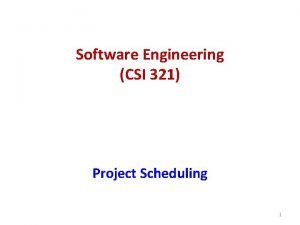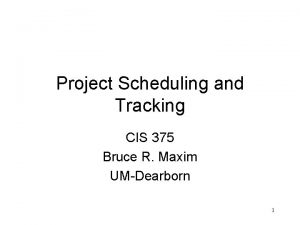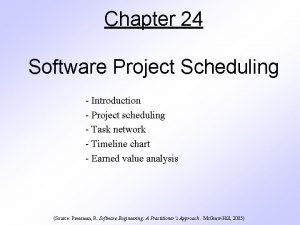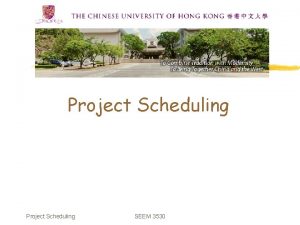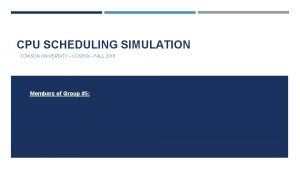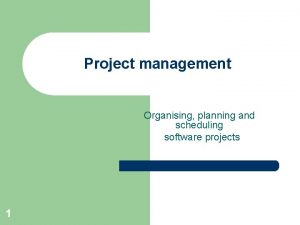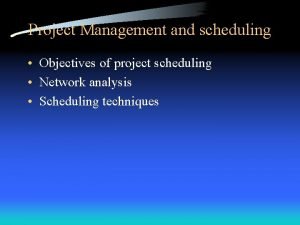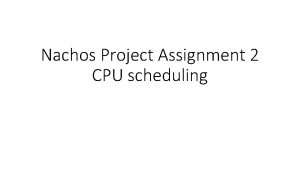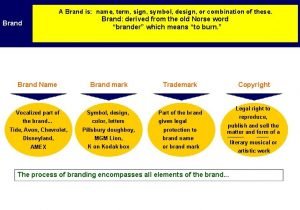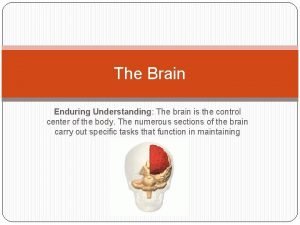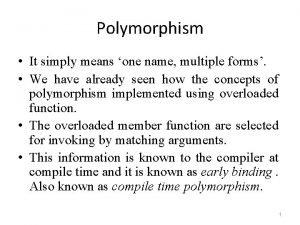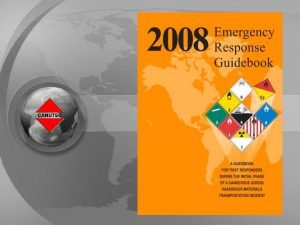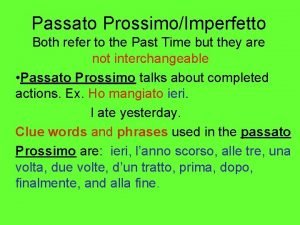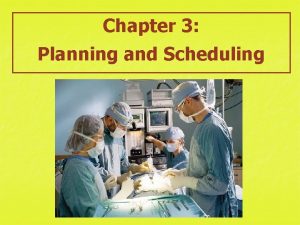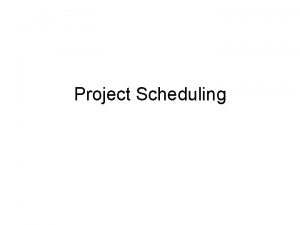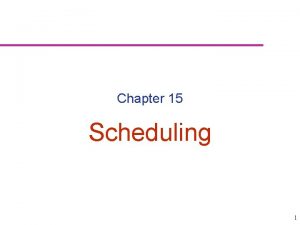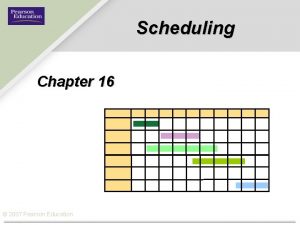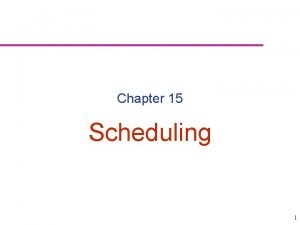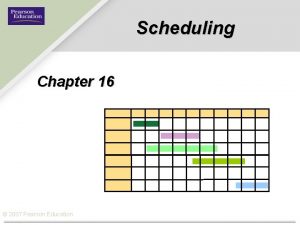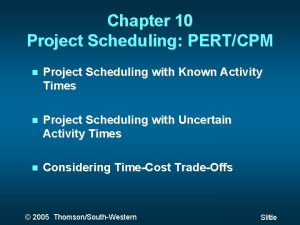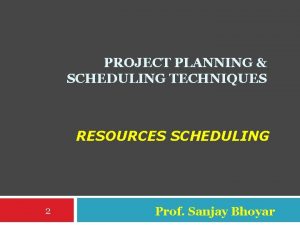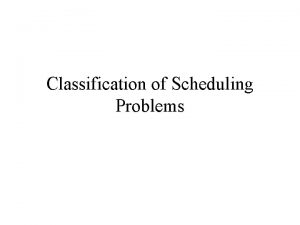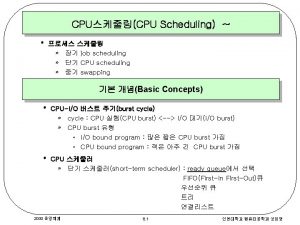Project Planning and Scheduling Refer to Chapter 10




































- Slides: 36

Project Planning and Scheduling (Refer to Chapter 10 of the textbook. Contains some additional information. )

Scheduling • • The process of converting a general or outline plan for a project into a time-based graphic presentation given information on available resources and time constraints Determining when an activity should start or end, depending on its – – – • duration, predecessor activity (or activities), predecessor relationships, resource availability, and target completion date of the project Setting an order and time for planned events

Preconstruction Planning • Must be viewed as an opportunity to design and build the project on paper before actual construction • Allows all entities involved to visualize the process and make necessary provisions to coordinate it • Provides an estimate of the time required for each portion of the project as well as the total project • Establishes the planned rate of progress • Forms the basis for managers to issue instructions to the subordinates • Establishes the planned sequence for the use of personnel, materials, equipment, and money

Construction Scheduling • Essential for efficient coordination of daily activities • Orchestration of timely and sequential delivery of the items of work • Enables one to prepare the checklist of key dates, activities, and resources • Provides a means for evaluating the effect of changes and delays • Serves as a basis for evaluating progress • Helps in the coordination of resources

Post-Construction Scheduling • Scheduling for commissioning, testing, acceptance • Helps coordinating and controlling works to correct deficiencies and incomplete items • Permits a review and analysis of the project as actually carried out • Provides historical data for improving future planning and estimating

Process • Establish objectives – Begins with a plan – Must be defined as a specific and measurable goal – Must be attainable and fit your company’s goals • Identify project activities – Breakdown the project into definable work activities – Activities should be action-oriented, visible, and measurable – Activities should be sorted by area, category, and phase

Process • Determine activity sequence – – Determine when to start an activity Preceding activity Succeeding activity Activities that can be done concurrently • Requires more resources, greater work space, and a higher level of control • Determine activity duration – Determine the time required to complete an activity – Calculate the duration required to complete an activity most effectively – Determine critical path


Process • Perform schedule calculations – Add up the durations of the different activity sequences or paths – The longest path determines the duration of the project – Paths with shorter durations have extra time • Float or slack – Provides a list of specific start and finish times for all activities – Activities along shorter paths will have some degree of flexibility – Those with longer paths will not have any flexibility • Labeled as critical

Process • Revise and adjust – An interactive process – It may be necessary to defer some work, increase workforce, plan overtime to meet project goals – Direct costs may increase if duration is shortened, but indirect costs may go down • Crashing

Process • Monitor and control – Baseline or target schedule defines the beginning of work – Changes to the baseline occur due to • Revisions in scope • Unforeseen conditions • Errors – Make appropriate adjustments to keep the forecasted completion date – Baseline schedule is kept secure – Revisions are sequentially labeled – Important in the event of future dispute

Scheduling Principles • Establish a logical sequence of operations • Plan to complete the work with resources that are available • Provide for continuity of operations • Start critical activities (i. e. controlling activities) early

Scheduling Methods • Bar Graph Method – Bar Graph Schedule • Graphical representation of progress of items of works in relation to a time schedule • Developed by Henry Gantt • Simple and most widely used form of schedule


Scheduling Methods – Cumulative Project Progress • Scheduled cumulative progress of works can be calculated after bar graph has been prepared and weighted factor calculated for each activity

Scheduling Methods – Scheduled cumulative Progress @ end of 3 rd week • (1. 00 x 4. 7)+(1. 00 x 0. 9)+(0. 40 x 26. 4) = 16. 20% – Actual cumulative Progress @ end of 3 rd week • (0. 90 x 4. 7)+(1. 00 x 0. 9)+(0. 25 x 26. 4) = 11. 73%



Scheduling Methods – Normal Progress Curve • • • S-curve Based on the observation of a large number of projects Slow progress at the beginning and end Steep progress between 15% and 85% of the work Usually about 15% of a project is completed in first 25% of project time • About 85% of a project is completed in 75% of project time • Applies to any type of non-repetitive work • Investigate reasons if scheduled cumulative progress curve deviates substantially from normal progress curve


Scheduling Methods • Matrix schedule – Schedule using a rectangular array of elements (or entries) set out by rows and columns – Simple tool for controlling field activities – Usually used for repetitive works – Does not consider all project activities Activity Scheduled Actual Start foundation works 11. 24. 07 11. 25. 07 Finish foundation works 11. 26. 07 11. 28. 07 Duration in days 2 3

Scheduling Methods • Network Schedules – Critical Path Method (CPM) • Technique that analyzes what activities have the least amount of scheduling flexibility (i. e. , are the most critical) and then predicts project duration schedule based on the activities that fall along the “critical path. ” • Identifies activities that control project duration – Critical activities • Developed by Du. Pont and Remington Rand – Project Evaluation and Review Technique (PERT) • It is an event-oriented planning aid, usually computerized, used to estimate project duration when there is uncertainty in estimates of duration times for individual activities.

Scheduling Methods – Both CPM and PERT use network diagrams – Graphically represent all the activities of a project – Show the relationship between activities – Difference between CPM and PERT • CPM assigns each activity a single fixed duration • PERT utilizes probability concepts to deal with uncertainties associated with activity-time estimates


Creating Schedule • Activity Definition – Categories of activities • Production – On-site construction • Procurement – Equipment and materials – Preparation and approval of submittals – Manufacturing and shipping of materials to site • Administration – Inspections – Permits

Creating Schedule • Network Diagrams – Activity on arrow • Each activity is represented by an arrow • Activities shown using dashed arrows are dummies – Used to impose logic constraints and prevents duplication of activities – They do not represent any work – Activity on node • Each node represents an activity – Precedence • An extension of AON • Provides information on lag time factors

Precedence Diagram

Creating Schedule • Event-Time Calculations – Calculate the earliest time at which each event may occur based on an arbitrary start time of zero • Early event time (EET) • Placed above the event circle – Proceed with calculations • Proceed from left to right • Start with 0 at the first event – Forward pass

Early event times

Creating Schedule – Proceed with calculations (contd. ) • When two or more activity arrows meet at an event, the largest of the early event times is chosen as EET • By definition, the event cannot occur until all activities leading to the event have been completed • Compute latest possible time at which each event may occur without changing the project duration – Backward pass – Late event time (LET)

Late event times

Creating Schedule – Proceed with calculations (contd. ) • LET of the last event is set equal to the EET of the event • Work backward through the network to calculate each event LET • LET of an event = LET of the predecessor event – duration of the event • When two or more activities meet at an event, the lower of the possible times is chosen as the LET – By definition, they must occur before any activity leading out of the event may start • LET is placed below the event circle

Creating Schedule • Critical Path – Path through the network that establishes the minimum project duration – Consists of the series of events and activities that is used to determine the EET of the final event – Wait until both EETs and LETs have been established to mark the critical path – It passes through all the events whose EET and LET are the same – Critical activities are the ones that connect the events on the critical path

Critical path

Creating Schedule • Activity times – – – Early start (ES) = EET of preceding event Early finish (EF) = ES + Activity duration Late finish (LF) = LET of the following event Late start (LS) = LF – Activity duration Total float (TF) = LF – EF • or – Total float (TF) = LS – ES – Activity times are not calculated for dummy activities

Activity-time data
 Sjn scheduling
Sjn scheduling Inventory management and production planning and scheduling
Inventory management and production planning and scheduling Media selection and scheduling
Media selection and scheduling Detailed scheduling
Detailed scheduling Carlsberg supply chain
Carlsberg supply chain Pulsing scheduling examples
Pulsing scheduling examples Disaggregating the aggregate plan
Disaggregating the aggregate plan Sdm in project management
Sdm in project management Compartmentalization interdependency effort validation r
Compartmentalization interdependency effort validation r Project scheduling in software engineering
Project scheduling in software engineering Compartmentalization interdependency effort validation r
Compartmentalization interdependency effort validation r Scheduling principles in software engineering
Scheduling principles in software engineering Identify critical path
Identify critical path Cpu scheduling project
Cpu scheduling project What is a project schedule
What is a project schedule Objectives of scheduling
Objectives of scheduling Cpu scheduling project
Cpu scheduling project Refer and monitor
Refer and monitor Name term sign symbol is known as
Name term sign symbol is known as N planning
N planning Short medium and long term planning in education
Short medium and long term planning in education Language planning slideshare
Language planning slideshare What does the underlined word mean ?
What does the underlined word mean ? Sample of appendices in research paper
Sample of appendices in research paper To refer to casually or indirectly
To refer to casually or indirectly Refer to the diagram for athletic shoes
Refer to the diagram for athletic shoes Part of the brain controls breathing
Part of the brain controls breathing 60 soft skills
60 soft skills One name multiple form refers to
One name multiple form refers to Why do we refer
Why do we refer Orange section of erg
Orange section of erg Attributional errors
Attributional errors People often refer to taxes
People often refer to taxes Cappuccino romman shisha
Cappuccino romman shisha Refer al past simple
Refer al past simple Medical terms with word elements that refer to color
Medical terms with word elements that refer to color Noncash items refer to
Noncash items refer to

